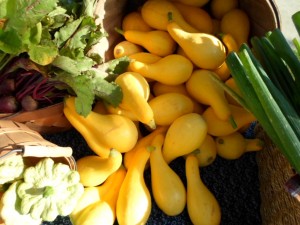Now that the days are warming up, yellow squash is growing very well in my garden. Based on other vendor booths at the farmers’ markets, I’d say it is growing well for them too. Most individuals who planted squash in the home garden find that it produces more than they can consume. That’s good because friends and neighbors usually benefit as well. A friend told me that Texas is the only place she’s had someone break into her vehicle and leave something instead of taking something. They left squash.
Squash is great picked young, chopped and eaten raw in a garden salad. It is certainly good boiled in salted water and then served with a small amount of real butter. I like to lightly toss it with other vegetables in olive oil, salt, pepper and thyme or rosemary and then oven-roast it. Try it on the grill when grilling hamburgers and serve it as a side instead of French fries. Mmmm, now I’m getting hungry for a veggie panini sandwich.
Before I get too carried away with all the ways to use squash, my favorite recipe, one that freezes well too, is squash casserole. The recipe is similar to one served at The Black-eyed Pea, but of course I’ve modified it a little. I’ve reduced the sugar and added freshly chopped thyme. The recipe serves 6, and each serving has 146 calories and 5 grams of fat. Served with a lean meat and side salad dressed with lemon juice, it is a great healthy meal.
Squash Casserole
2 lbs. yellow squash
1 Tbsp. butter, softened
1 cup bread crumbs, divided
1 Tbsp. sugar
1⁄2 tsp. salt
1 tsp. fresh thyme, chopped
1 Tbsp. dehydrated onion
2 ea. eggs
1 pinch pepper
Wash and cut squash into 2” cubes and cook in lightly salted boiling water until done. Drain well, mash and continue to drain for about 10 minutes.
In a bowl, combine all the ingredients except for half of the bread crumbs. Place mixture in a lightly greased 2-quart casserole dish. Top with the remaining bread crumbs.
Bake covered in a 350-degree oven for 20 minutes. Uncover and bake for about 10 minutes more or until the crumbs on top are lightly browned.
Using dehydrated onions is important as they help absorb liquid. If using fresh onions, make sure the squash has drained really well or else the casserole won’t set – I’m sure it will still taste good.
Next week I’ll share a pickled squash recipe. There are just too many recipes for squash to fit them all in this article.

